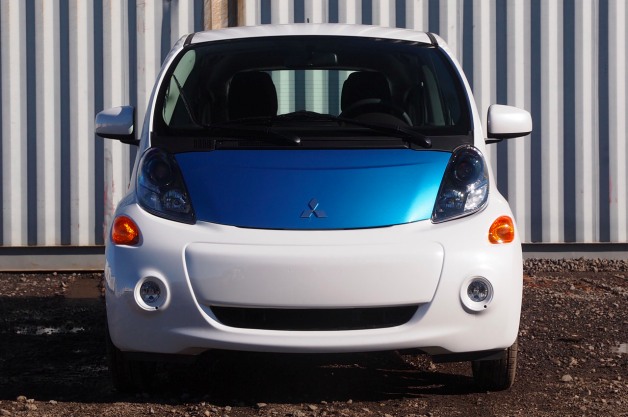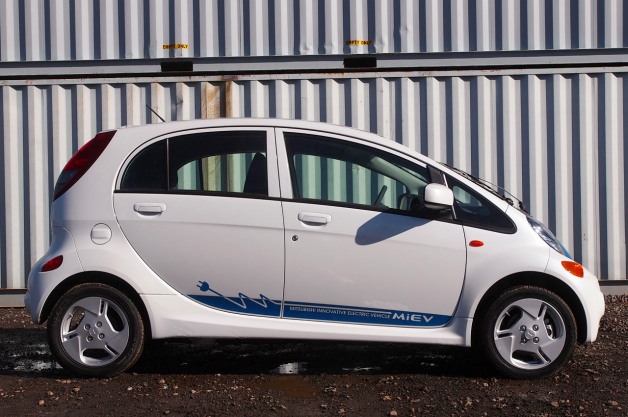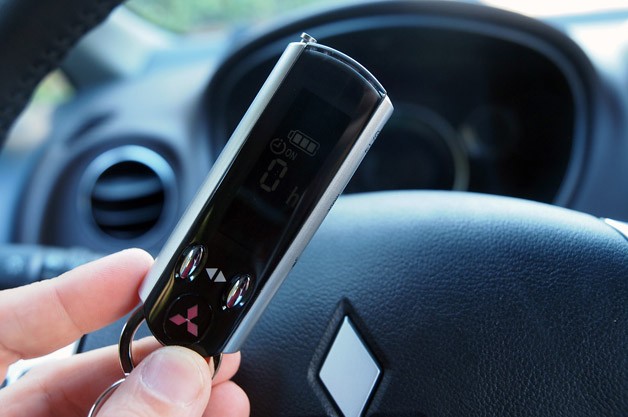An affordable, semi-practical, entry-level EV
I've driven a fair number of electrics over the last couple decades, beginning with General Motors' bullet-shaped 1991 Impact concept car and continuing through a progression of Geo Storm-based mules, prototype and production EV1s with both lead-acid and later range-doubling Ni-MH battery packs. And since returning to this side of the business, my list has expanded to include the Chevrolet Volt, Nissan Leaf, MINI E, BMW ActiveE, Tesla Roadster, Smart ED and a right-drive, Japanese-market Mitsubishi i-MiEV.
All have shared the EV blessings of strong, near-silent, shiftless acceleration, home "refueling" and no more gas station stops with fluctuating fuel prices. All have also shared the EV curses of big, heavy, expensive batteries, the resulting high purchase/lease prices and (excluding the Volt) limited range, long recharge times and occasional range anxiety.
Most recent EV encounters have been brief – a few miles around town or a parking lot. But last year I was fortunate to enjoy a working week with a Volt and a couple days with a Leaf (see past columns). And I was recently offered a three-day loan of a U.S.-spec Mitsubishi i.

The i is powered by 49-kW (66-hp) AC synchronous motor mounted low in its sawed-off hatchback tail and driving its rear wheels, making it kind of like an early Volkswagen Beetle in layout and concept. Its 16-kWh li-ion battery pack (the same size as the Volt's) resides under the rear seats.
Like the Leaf, the i was trucked out to my house (some 90 miles from its base) and delivered fully charged. Also like the Leaf, it wouldn't get me to a Detroit-area meeting the next day (and back), so I had to drive a conventional car, just as owners will need to do for non-local trips and vacations. The i may be a great, no-gas, green car for urban use and common commutes, but (as GM said about EV1) it will be a second or third vehicle in most owners' households.

When I did drive it, I pulled out with full batteries and 52 miles of indicated range (based on the previous driver's rate of usage). I ran some local errands, then took my wife out to dinner, driving normally and mostly in range-optimizing "Eco" mode. The two other shifter-selectable modes are "D" for best performance and "B," which further maximizes range with aggressive regenerative braking. We found its performance respectable in D but the regen was a bit much in B mode.
We drove 23 miles and returned home with 43 miles on the range gauge, indicating a total around-town potential of 66 miles. Later that night, a test run on my local test loop used 30 miles of indicated range over just 12.5 miles of actual pavement. I drove the i fairly hard, mostly in D with some use of B mode, at 50F ambient temperature, leaving me an indicated 13 miles remaining.
I found the 120V cord typically thick and heavy and surprisingly short. It barely stretched from a garage wall socket over a (small) adjacent car to the i's charge port, and a big, heavy box on its wall end had to be supported to keep it from pulling the plug out of the socket. (As I recall, the Volt and Leaf 120V charge cords also had this unfortunate appendage.)

I didn't use the fob's programming capability to set start/stop times or check SOC, just let it charge from midnight to 9:00 am. That resulted in about an 80 percent SOC and an indicated range of 33 miles (anticipating more hard driving). Mitsubishi says a full charge from zero to 100 percent will require 22.5 hours on 120V and seven on 240V. If the car is so equipped (and a station can be found), a Level 3 DC quick charge to 80 percent will take 30 minutes.
Evaluated as a car, the i falls short in several areas. Styling is subjective, but we thought it an odd-looking little duck. We liked the larger and more practical Leaf's exterior better (despite its frightened-fish face) and its comfy, quiet, nicely-done interior much better. The i's rear seats are livable for two adults, but at the expense of front-seat travel. At six feet with long legs, I was cramped and uncomfortable in the driver's seat.
As the most affordable EV available in the U.S. from a volume automaker, its doors were light and thin and sounded tinny when closed, and its interior was sparse and cheap even by today's entry-level small-car standards. On the road, its steering felt stiff and artificial, and its handling was tippy, as if its tall, narrow body were suspended by a single central spring over its four tiny wheels.
All things considered, I was not sorry to see the i trucked away. That was not the case with the Volt or the Leaf, both of which I could have happily lived with much longer-term. Mitsubishi deserves kudos for bringing this affordable and otherwise fairly livable little EV to the North American market, but we don't see Americans signing up for very many of them.
I've driven a fair number of electrics over the last couple decades, beginning with General Motors' bullet-shaped 1991 Impact concept car and continuing through a progression of Geo Storm-based mules, prototype and production EV1s with both lead-acid and later range-doubling Ni-MH battery packs. And since returning to this side of the business, my list has expanded to include the Chevrolet Volt, Nissan Leaf, MINI E, BMW ActiveE, Tesla Roadster, Smart ED and a right-drive, Japanese-market Mitsubishi i-MiEV.
All have shared the EV blessings of strong, near-silent, shiftless acceleration, home "refueling" and no more gas station stops with fluctuating fuel prices. All have also shared the EV curses of big, heavy, expensive batteries, the resulting high purchase/lease prices and (excluding the Volt) limited range, long recharge times and occasional range anxiety.
Most recent EV encounters have been brief – a few miles around town or a parking lot. But last year I was fortunate to enjoy a working week with a Volt and a couple days with a Leaf (see past columns). And I was recently offered a three-day loan of a U.S.-spec Mitsubishi i.

The i is powered by 49-kW (66-hp) AC synchronous motor mounted low in its sawed-off hatchback tail and driving its rear wheels, making it kind of like an early Volkswagen Beetle in layout and concept. Its 16-kWh li-ion battery pack (the same size as the Volt's) resides under the rear seats.
The $21,625 base ES version rolls on 15-inch alloy wheels with a two-tone interior, eight-speaker audio system, a leather-wrapped steering wheel, fog lamps and auto on/off headlamps. Two grand more buys the SE model with navigation, a rear camera, steering wheel audio controls, a FUSE Handsfree Link System with a USB port and a DC quick-charge port (a $700 option on the ES). A $150 Cold Zone Package adds battery warming and heated outside mirrors, and a $2,790 Premium Package piles on a bunch more. The EPA rates it at 112 MPGe (gasoline equivalent), the best, so far, of any U.S.-market production vehicle, and says the i has a real-life estimated range of 62 miles and an LA4 city-cycle range of 98 miles.The i may be a great, no-gas, green car for urban use and common commutes, but it will be a second or third vehicle in most owners' households.
Like the Leaf, the i was trucked out to my house (some 90 miles from its base) and delivered fully charged. Also like the Leaf, it wouldn't get me to a Detroit-area meeting the next day (and back), so I had to drive a conventional car, just as owners will need to do for non-local trips and vacations. The i may be a great, no-gas, green car for urban use and common commutes, but (as GM said about EV1) it will be a second or third vehicle in most owners' households.

When I did drive it, I pulled out with full batteries and 52 miles of indicated range (based on the previous driver's rate of usage). I ran some local errands, then took my wife out to dinner, driving normally and mostly in range-optimizing "Eco" mode. The two other shifter-selectable modes are "D" for best performance and "B," which further maximizes range with aggressive regenerative braking. We found its performance respectable in D but the regen was a bit much in B mode.
We drove 23 miles and returned home with 43 miles on the range gauge, indicating a total around-town potential of 66 miles. Later that night, a test run on my local test loop used 30 miles of indicated range over just 12.5 miles of actual pavement. I drove the i fairly hard, mostly in D with some use of B mode, at 50F ambient temperature, leaving me an indicated 13 miles remaining.
I found the 120V cord typically thick and heavy and surprisingly short. It barely stretched from a garage wall socket over a (small) adjacent car to the i's charge port, and a big, heavy box on its wall end had to be supported to keep it from pulling the plug out of the socket. (As I recall, the Volt and Leaf 120V charge cords also had this unfortunate appendage.)

I didn't use the fob's programming capability to set start/stop times or check SOC, just let it charge from midnight to 9:00 am. That resulted in about an 80 percent SOC and an indicated range of 33 miles (anticipating more hard driving). Mitsubishi says a full charge from zero to 100 percent will require 22.5 hours on 120V and seven on 240V. If the car is so equipped (and a station can be found), a Level 3 DC quick charge to 80 percent will take 30 minutes.
Evaluated as a car, the i falls short in several areas. Styling is subjective, but we thought it an odd-looking little duck. We liked the larger and more practical Leaf's exterior better (despite its frightened-fish face) and its comfy, quiet, nicely-done interior much better. The i's rear seats are livable for two adults, but at the expense of front-seat travel. At six feet with long legs, I was cramped and uncomfortable in the driver's seat.
As the most affordable EV available in the U.S. from a volume automaker, its doors were light and thin and sounded tinny when closed, and its interior was sparse and cheap even by today's entry-level small-car standards. On the road, its steering felt stiff and artificial, and its handling was tippy, as if its tall, narrow body were suspended by a single central spring over its four tiny wheels.
Given that the i is intended primarily as a low-speed urban EV, much of that might be forgiven. But the final disqualifier (for me, at least) was its cantankerous audio system. It took a full six minutes or more (of dead silence) to "read" my iPod each time I plugged it into the USB port, then was user-unfriendly in other ways. I test drive 100-plus new vehicles each year, and the only others in which I have encountered this problem have been a couple other (otherwise pretty decent) recent Mitsubishi products. It's a major customer dissatisfier.All things considered, I was not sorry to see the i trucked away.
All things considered, I was not sorry to see the i trucked away. That was not the case with the Volt or the Leaf, both of which I could have happily lived with much longer-term. Mitsubishi deserves kudos for bringing this affordable and otherwise fairly livable little EV to the North American market, but we don't see Americans signing up for very many of them.


Sign in to post
Please sign in to leave a comment.
Continue